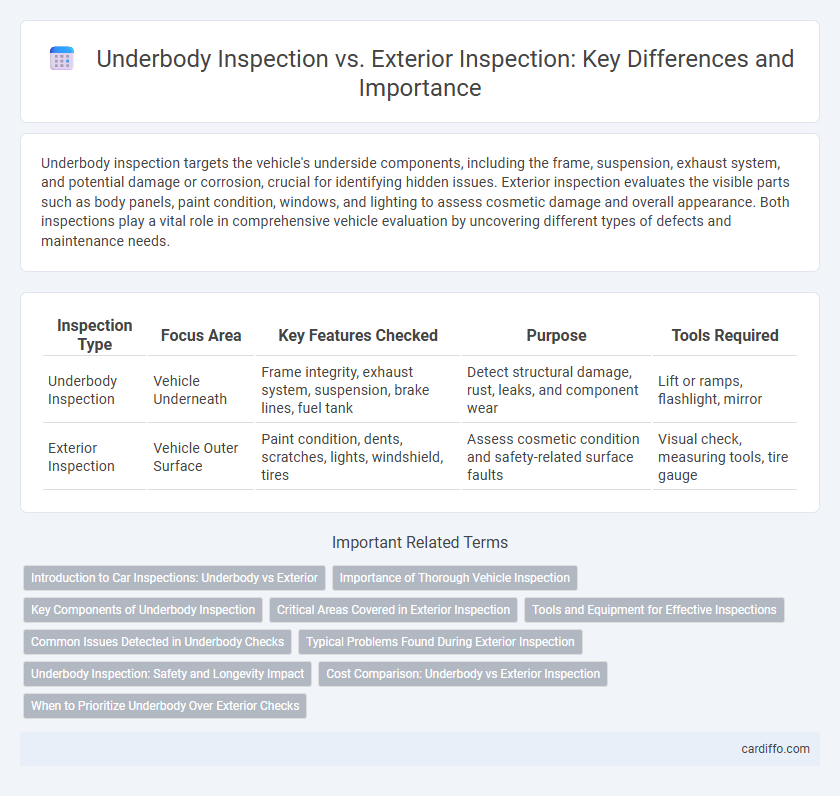Underbody inspection targets the vehicle's underside components, including the frame, suspension, exhaust system, and potential damage or corrosion, crucial for identifying hidden issues. Exterior inspection evaluates the visible parts such as body panels, paint condition, windows, and lighting to assess cosmetic damage and overall appearance. Both inspections play a vital role in comprehensive vehicle evaluation by uncovering different types of defects and maintenance needs.
Table of Comparison
| Inspection Type | Focus Area | Key Features Checked | Purpose | Tools Required |
|---|---|---|---|---|
| Underbody Inspection | Vehicle Underneath | Frame integrity, exhaust system, suspension, brake lines, fuel tank | Detect structural damage, rust, leaks, and component wear | Lift or ramps, flashlight, mirror |
| Exterior Inspection | Vehicle Outer Surface | Paint condition, dents, scratches, lights, windshield, tires | Assess cosmetic condition and safety-related surface faults | Visual check, measuring tools, tire gauge |
Introduction to Car Inspections: Underbody vs Exterior
Underbody inspection focuses on examining a vehicle's frame, suspension, exhaust system, and drivetrain components to identify rust, damage, or leaks that affect safety and performance. Exterior inspection evaluates the car's body panels, paint, lights, windows, and tires for cosmetic damage, alignment issues, and proper functionality. Both inspections are critical for comprehensive vehicle assessment, ensuring optimal safety, durability, and resale value.
Importance of Thorough Vehicle Inspection
A thorough vehicle inspection requires careful evaluation of both the underbody and exterior to identify potential safety hazards and mechanical issues. Underbody inspection reveals critical components such as the suspension, exhaust system, and frame integrity that are not visible during an exterior check. Exterior inspection focuses on detecting damage to the body, paint, lights, and windows, ensuring overall vehicle safety and appearance.
Key Components of Underbody Inspection
Underbody inspection focuses on critical components such as the vehicle's frame, suspension system, exhaust system, brake lines, and fuel lines, all of which are essential for structural integrity and safety. This inspection detects signs of rust, corrosion, leaks, and damage that are often hidden from exterior view, providing a more comprehensive assessment of the vehicle's condition. Unlike exterior inspection, which primarily evaluates body panels and paint quality, underbody inspection ensures key mechanical and safety elements are monitored for optimal performance and longevity.
Critical Areas Covered in Exterior Inspection
Exterior inspection prioritizes critical areas such as paint integrity, body panel alignment, and glass condition, which are essential for vehicle safety and aesthetics. Special attention is given to door seals, lights, mirrors, and tire condition to ensure functionality and compliance with safety standards. These aspects directly impact visibility, aerodynamics, and protection against corrosion, making them vital in maintaining overall vehicle performance.
Tools and Equipment for Effective Inspections
Underbody inspection tools include high-intensity LED inspection lights, creepers for easy maneuverability, and ultrasonic thickness gauges to detect rust or damage on vehicle frames. Exterior inspection relies on UV lamps for paint defect detection, digital cameras for detailed imaging, and handheld magnifiers to assess surface imperfections. Using specialized equipment tailored to each inspection type ensures thorough diagnostics and enhances maintenance accuracy.
Common Issues Detected in Underbody Checks
Underbody inspection commonly detects issues such as rust and corrosion on the frame, damaged or leaking exhaust systems, and worn suspension components. It also reveals problems with brake lines, fuel lines, and undercarriage fluid leaks that are often missed during exterior inspections. Identifying these issues early helps prevent costly repairs and ensures vehicle safety and performance.
Typical Problems Found During Exterior Inspection
Typical problems found during exterior inspection include paint damage, rust spots, dents, and broken or misaligned trim components. Inspection often reveals windshield cracks, headlight fogging, and damaged mirrors, which can impair visibility and safety. Exterior inspections also identify issues with door seals, window chips, and tire condition, critical for weather protection and proper vehicle operation.
Underbody Inspection: Safety and Longevity Impact
Underbody inspection plays a crucial role in vehicle safety and longevity by identifying rust, structural damage, and fluid leaks that are not visible during exterior inspections. Detecting these issues early prevents costly repairs and ensures the integrity of essential components such as the frame, suspension, and exhaust system. Regular underbody inspections improve roadworthiness and extend the lifespan of the vehicle by addressing hidden defects before they escalate.
Cost Comparison: Underbody vs Exterior Inspection
Underbody inspections typically incur higher costs than exterior inspections due to the need for specialized equipment like lifts and lighting, as well as trained personnel to safely access and assess hidden components. Exterior inspections are generally more cost-effective because they can be conducted quickly with minimal tools, focusing primarily on visible surface damage and cosmetic issues. The cost differential reflects the depth of inspection detail required and the complexity of accessing underbody areas compared to the more straightforward exterior examination.
When to Prioritize Underbody Over Exterior Checks
Prioritize underbody inspections when vehicle performance issues such as unusual noises, leaks, or handling problems arise, as these often stem from suspension, brake lines, or exhaust system damage hidden beneath the exterior. Routine exterior inspections may miss critical undercarriage corrosion, structural damage, or fluid leaks that compromise safety and vehicle integrity. For accurate diagnostics and preventative maintenance, emphasize underbody checks during off-road use, post-collision assessments, or exposure to harsh environmental conditions like salted roads or floods.
Underbody inspection vs exterior inspection Infographic

 cardiffo.com
cardiffo.com